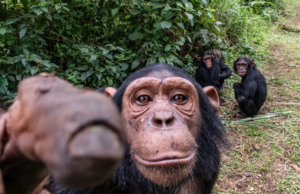ZOO CHIMP PLANNED ATTACKS
March 9th 2009: A male chimpanzee in a Swedish zoo planned hundreds of stone-throwing attacks on zoo visitors, according to a paper published this week in journal Current Biology. Keepers at Furuvik Zoo found that the chimpanzee Santino collected and stored stones that he would later use as missiles.
Crucial to the current study is the fact that Santino, a chimpanzee at the zoo in the city north of Stockholm, collected the stones in a calm state, prior to the zoo opening in the morning. The launching of the stones occurred hours later – during dominance displays and rejection of zoo visitors – with Santino in an "agitated" state.
This suggests that Santino was anticipating a future mental state – an ability that has been difficult to definitively prove in animals, according to Mathias Osvath, a cognitive scientist from Lund University in Sweden and author of the new research.
"We\’ve done experimental studies, and the chimps in my mind show very clearly that they do plan for future needs, but it has been argued that perhaps this was an experimental artefact," Dr Osvath told BBC News. Now we have this spontaneous behaviour, which is always in some sense better evidence."
Dr Osvath embarked on the study after zoo staff discovered caches of stones in the section of the enclosure facing the public viewing area. Since the initial discovery in 1997, hundreds of the caches have been removed to protect visitors, to whom the caching and the aggressive displays seem strictly related; in the off season, Santino neither hoards the projectiles nor hurls them.
Further, the chimp learned to recognise how and when parts of his concrete enclosure could be pulled apart to fashion further projectiles. When water seeps into cracks in the concrete and freezes, portions become detached that make a hollow sound when tapped.
Santino was observed gently knocking on the "boulders", hitting harder to detach bits that were loosened and adding those to his stashes of ammunition.
There are a number of examples of complex behaviour in apes that suggest forms of consciousness. Planning behaviour like that of the current work is connected to so-called autonoetic consciousness, where information due to memory can be distinguished from that from the senses. "I\’m personally convinced that at least chimps do plan for future needs, that they do have this autonoetic consciousness," Dr Osvath said.

 Español
Español
 Português
Português








